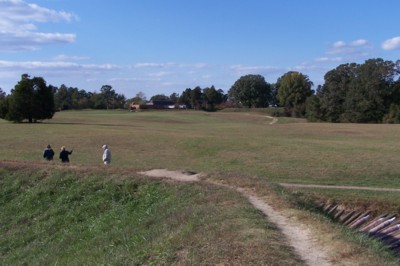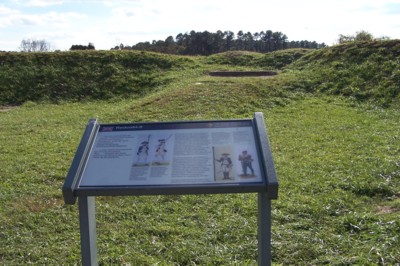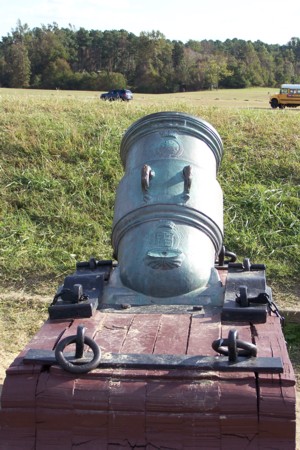|
Support Ghost Guns
|
Walking Tour of Redoubts 9 and 10, October 25, 2006
by Caroline Miniscule
It was a cold, windy October day in York County, Virginia, and I decided to drive over to Yorktown Battlefield and do some shooting (with a camera, of course).
It's possible to drive, or even bike, around the battlefield in a day, but to really experience it properly, visitors should take their time. Set aside at least two days to take it all in.
Today, I decided to look at the British Redoubts 9 and 10.
To get to these redoubts, following my route originating in York County or Newport News, drive north down George Washington Memorial Blvd, also known as Highway 17. You'll pass through York County (not to be confused with Yorktown), and then Grafton.
|
You'll start to pass signs for the Yorktown Victory Center, but before you get there, you'll come to an exit for Cook Road. Turning right onto Cook Road will bring you straight to the Yorktown Visitor Center and the battlefield itself.
Drive down to the end of Cook Road which intersects with Ballard Street. Turn left and then hang a right and you'll be at the Visitor Center. Turn right, however, and drive a few hundred yards. On your left hand side you will see a sign for Redoubts 9 and 10. Turn left, and as you drive up to a small parking area, you'll pass a sign for the Communicating Trench on your right.
Park in the small area here, and you'll find the beginning sign for your walking tour, which explains the significance of Redoubts 9 and 10.
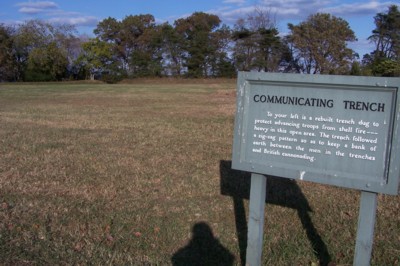
Driving up to the parking lot to begin the walking
tour of the redoubts, you pass this sign.
|
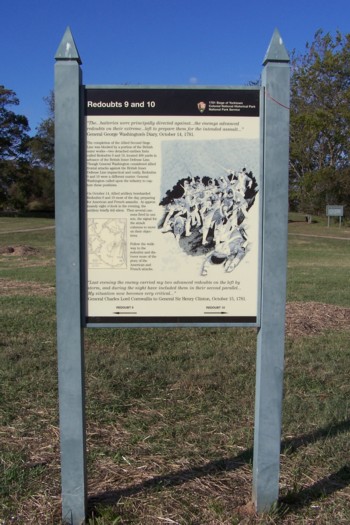
Sign that begins the walking tour of Redoubts 9 and 10. |
Despite the chilliness of the day, there were a handful of people walking along the route. They were of all ages - elderly couple, a family with young children, another with teens...a single middle aged man with a camera.
As I wandered around the trails that wound around the remains of Redoubts 9 and 10, I found myself wondering when all of these signs had been erected. I examined all of the tablets and all of the signs, and the vast majority had no date. All of the signs seemed in good shape, but there were the usual weatherings. The signs were all uniform, either painted blue with white text, or taller ones with a cream-colored face and illustrations as well as text. There were two tablets set into stone.
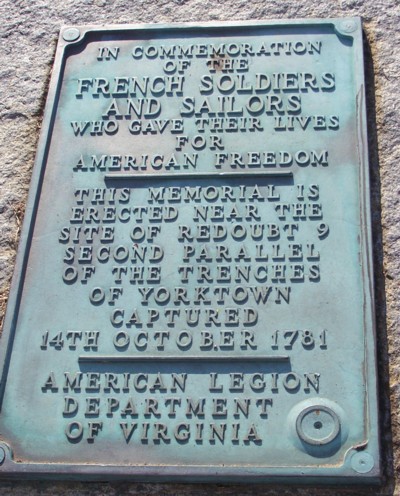
Tablet commemorating the fallen French soldiers and sailors of the American Revolution.
|
After viewing the main sign, you have the choice of turning right to view the remains of Redoubt 10 (most of it has disappeared, as 150 feet of the coast has eroded into the York River in the last 225 years). Turn to your left. This looks much more interesting as there's lots of cannons to see.
So turn to your left, and you'll see the raised mounds that comprise Redoubt 9.
You walk over a small bridge, and along a path towards the second seige line and Redoubt 9. As you move forward you can go slightly to your left or slightly to your right. To your left you'll see the Grand American Battery, a series of mortars and cannon, but if you walk to the right, in front of these mounds, you'll find the French commemorative tablet shown here.
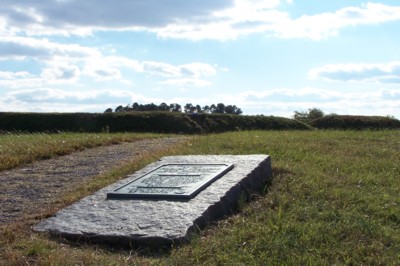
The Commemorative French tablet, and the earthworks of Redoubt 9
|
The dictionary definition of a redoubt is: "an independent earthwork built within a permanent fortification to reinforce it."
|
As I got closer to the mound, I saw that it was surrounded by a ditch and had sharpened stakes bristling out of it, and I found myself wondering how long those stakes had been in there.
Everything on the battlefield - the cannons and these stakes, are reproductions. A research note I have made to myself is to find out how long the battlefield has been in its present state of 'display,' I think it's been this way since 1956. (That's when the remains of Redoubt 10 were found, as I discovered when I made my way over to that area after a few minutes.)
A well-worn path led up into the middle of the redoubt, with yet more signs. Although it was cold, the sun was shining brightly, and that always plays havoc with digital cameras (or at least, with my camera, so I spent some time trying to find shots so that I could have the sun at my back.
| 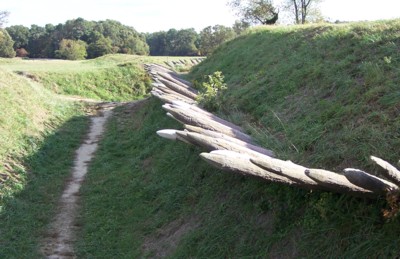
Long sharpened stakes protruding from the earthworks. |
I then walked around the redoubt and back the way I'd come, this time walking past the cannons and mortars which turned out to be the Grand American Line. (I came across the explanatory sign after I'd walked past the artillery from the other direction. The photo to the right below is heading toward the sign.)
There were a few teens running along the top of the earthworks, laughing and having fun and probably not a thought in their heads about what had taken place on that field so many years ago.
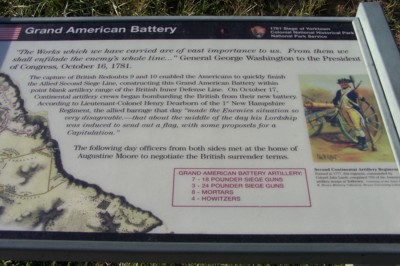
Explaining the Grand American Battery
| 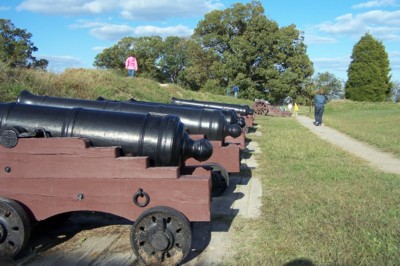
Cannons here, mortars further along (by the sign on the left) |
I then retraced my steps, and headed over to Redoubt 10. As I explained above, most of Redoubt 10 doesn't exist anymore, having eroded away. You can't really see the York River from the location, as there's lots of foliage blocking the view, and a fence preventing people from getting down to the water's edge.
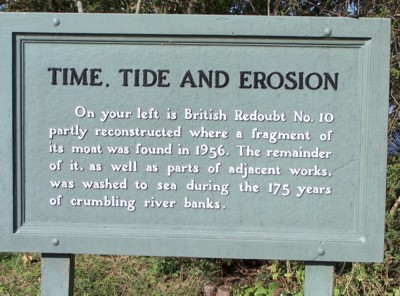
The sign explaining the condition of Redoubt No. 10 |
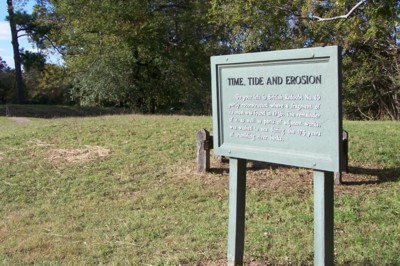
A bench behind the sign, with the redoubt beyond. |
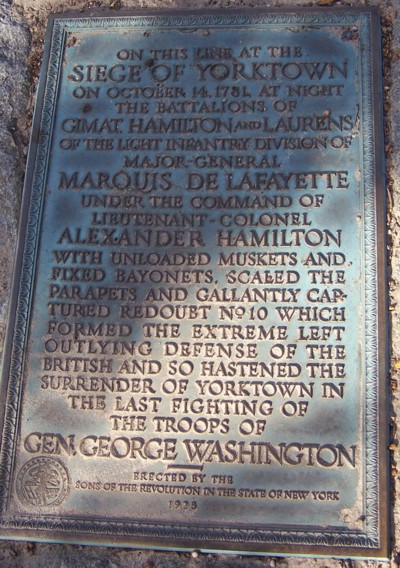
The only plaque or sign I saw with a date on it. This plaque was placed here in 1925. |
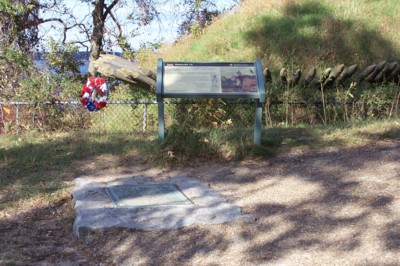
The plaque, the sign, the wreath, and the redoubt.
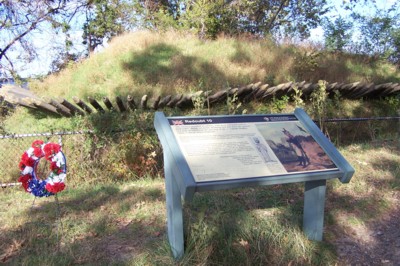
A wreath placed here on the Oct 19-22 long weekend.
|
On the sign for Redoubt 10 were two different illustrations - a large one of Patrick Henry, and a smaller one of an African-American infantryman. The contribution of African-Americans to Revolutionary War history has long been neglected, and so I really wonder when this sign was placed here. Of course, since the 1970s Virginian historians have made a concentrated effort to acknowledge the African-American contribution to both the Revolutionary and Civil Wars...another research point I have to work on.
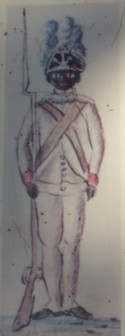
Closeup of section of the Redoubt 10 sign |
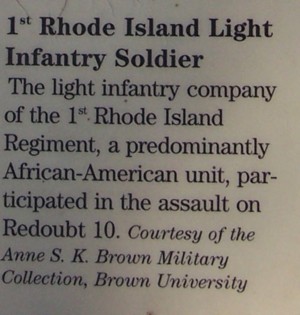
Closeup of section of the Redoubt 10 sign |
And finally, the peace and beauty of the battlefield today. Remember the past, learn from the past, peace for the future.
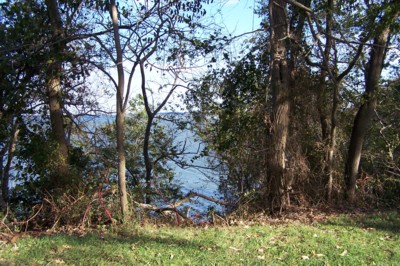
The York River, beyond Redoubt 10 |
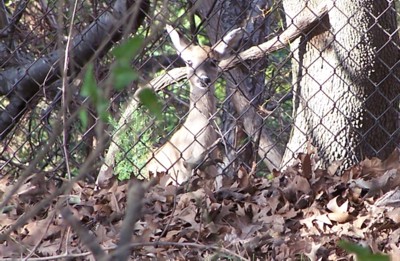
A young deer looking out curiously from behind the fence protecting the coastline |
|





